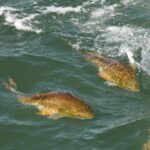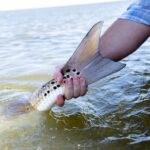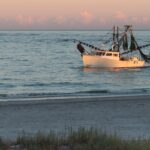
A Veteran Guide’s View of Jacks
If you’ve spent any time on the water in South Florida, chances are you’ve heard
Findings could help managers improve self-reporting rates to ensure long-term sustainability
In a recent blog, we highlighted how collecting timely and accurate data from the recreational fishing community continues to be a major challenge for managers, even though our sector can be responsible for the bulk of removals in popular fisheries. In recent years, managers at the state, regional, and federal levels have increasingly turned to smartphone apps in an effort to help keep a “finger on the pulse” of angler activity and catch. These apps have huge potential for helping to keep harvest within sustainable limits and thus promote stable, abundant fisheries.
But there’s a catch: Despite the proliferation of apps in recent years, successfully recruiting anglers to use them—and then to keep using them—has been a bigtime obstacle to successfully integrating these tools into the management process. Even when using such apps for catch reporting is mandatory, compliance with that requirement has been a persistent issue.
A prime example of this is the recreational Atlantic bluefin tuna fishery, which as many readers will know has been outstanding in the Northeast over the past several years, providing thrills for anglers and booked-solid seasons for guides. Bluefin tuna anglers are required to report all landings and dead discards, using the Highly Migratory Species (HMS) Catch Reporting App or via website or phone, within 24 hours. The requirement is intended to provide managers with a real-time estimate to ensure that recreational bluefin tuna landings stay within prescribed limits. In addition, U.S. recreational catch estimates of juvenile bluefin tuna are used to evaluate spawning success (recruitment) in the western Atlantic bluefin tuna stock assessment, underscoring the importance of collecting accurate data.
Despite the self-reporting requirement, it is believed that angler compliance coastwide is quite low, making it challenging for NOAA Fisheries’ HMS Management Division to track landings in real-time. Instead, to estimate bluefin tuna harvest the Division must rely on the Large Pelagics Survey, a specialized component of the Marine Recreational Information Program (MRIP), which operates on a one-month lag and does not support in-season management; this impedes managers’ ability to ensure that U.S. bluefin tuna harvest does not exceed its internationally allocated annual quota.
So, how do we get anglers over the hump? How we can help folks recognize that reporting their catch is in the best interest of the resource and can help support a healthy bluefin fishery for years to come?
To tackle this challenge, and with funding from the National Fish and Wildlife Foundation, the American Saltwater Guides Association partnered with the Virginia Institute of Marine Science and The Nature Conservancy to survey the roughly 2,700 permitted private bluefin tuna anglers in Massachusetts, with the goal of identifying steps that managers can take to improve self-reporting rates. As an epicenter of the east coast’s bluefin fishery in recent years, with anglers targeting and catching fish of varying sizes using a variety of methods (trolling, jig/pop, live bait, etc.), we thought it would be an appropriate representation of the broader fishery.
During the spring and summer of 2021, we designed an online survey with input from HMS Management Division Staff, administrators of other angler self-reporting programs, and Massachusetts bluefin tuna anglers themselves. The final survey included questions about bluefin tuna fishing experience and behavior, general attitudes about the fishery and its management, views on the self-reporting requirement, and, most critically, opinions regarding which strategies could be most effective for increasing self-reporting rates. Importantly, because we had information on which permit-holders had reported in the past versus those who hadn’t, we were able to compare (anonymized) responses based on past reporting behavior without having to ask anglers directly whether they had self-reported in the past (only about 250 of the 2700 anglers surveyed had ever done so). We distributed the survey in September 2021 through an email containing a link to the survey and a follow-up postcard containing both the survey link and a QR code.
Results and Key Takeaways
While we’ll be presenting the full results of our survey in a peer-reviewed manuscript, here are some key highlights of what we learned.
Overall, we received responses from nearly 600 anglers, for a response rate of about 22%, although nearly half of those who had reported in the past (“reporters”) responded compared to only about 20% of those who hadn’t (nonreporters). Thirty percent of the nonreporters who did complete the survey, however, indicated that they had harvested a bluefin tuna aboard their vessel in the previous five years. That amounts to nearly 60% of all survey respondent who said they’d recently harvested a bluefin—in other words, based on our responses, only about 40% of those who harvest bluefin tuna comply with the self-reporting requirement. What’s more, because our responses skewed more toward reporters, compliance may in reality be even lower. We were able to separately analyze responses from the subset of nonreporters who had not complied with the reporting requirement in the past, whom we called “noncompliers.”
One of the most striking results of our survey was the lack of difference in responses based on self-reporting history. For example, we found that, regardless of whether folks had reported in the past, over 90% of respondents indicated that they were aware of the need to self-report, suggesting that low reporting rates weren’t due to a lack of awareness. There was also near-universal agreement that reporting was important for ensuring the fishery’s long-term sustainability. We did find, however, that fewer noncompliers believed other anglers were aware of the requirement and self-reported compared to reporters.
We asked anglers to rate the effectiveness of both general and specific strategies that could be used to increase self-reporting on a scale from “not effective at all” to “extremely effective.” Regardless of their reporting behavior in the past, respondents thought the following general strategies would be helpful for increasing compliance: increasing awareness of the reporting requirement; increasing the user-friendliness of reporting technology; better communicating the reasons for/benefits of self-reporting; and working with recreational leaders to foster a “culture of reporting.” The fact that nearly two thirds of respondents thought increasing awareness of the need to self-report would be an effective strategy was surprising given the broad agreement that most anglers were aware of the self-reporting requirement. A “stick” (punishment) rather than “carrot” (reward) strategy—increasing the penalties for folks who didn’t self-report—elicited more mixed reviews, with noncompliers generally thinking they would be less effective than reporters.
When asked about what specific strategies managers could use to increase reporting rates, angler opinions on their effectiveness varied widely by the type of strategy, as you can see in the table below:

Incentives were certainly the most popular means for increasing compliance. The strategy most broadly viewed as effective was entering anglers who self-report into a low-odds, high-value lottery for an item such as a fishing reel; nearly two-thirds of respondents, regardless of past reporting history, believed it would be very or extremely effective. A lottery could, however, also lead to anglers’ submitting false reports (a “perverse incentive,” so to speak), so managers would have to be careful in designing such a program and perhaps find ways to verify catch.
The second- and third-most effective strategies in the eyes of anglers were also incentive-based: a) providing real-time updates on self-reported bluefin tuna landings over the course of a season; and b) sending “swag” like hats or t-shirts to those who self-reported. Unsurprisingly, those who had already reported in the past were less enthusiastic about real-time updates, maybe because doing so could lead to bigger crowds offshore in pursuit of bluefin.
“Reminder” strategies, such as emails over the course of the season, visual reminders at marinas/ramps, or asking about the previous season’s reporting when renewing a permit were viewed as moderately effective. The approaches viewed asleast effective, meanwhile, were those that imposed an additional burden on anglers through requiring them to either 1) self-report on all trips, including those with no catch/harvest; or 2) “hail-out” at the start of a trip. Both of these techniques have been used to increase compliance in other recreational self-reporting programs. For both, though, over 50% of respondents thought they would not be effective at all.
Key Takeaways
Overall, our survey revealed that, while there is broad awareness of the self-reporting requirement among Massachusetts recreational bluefin tuna anglers, compliance with that requirement continues to be low—only about 40%, according to our results. There was, however, interest in incentive-based approaches for increasing self-reporting rates. In addition, there may be opportunities for NOAA Fisheries to improve its reporting technology and conduct outreach and communications approaches to ensure that anglers understand the self-reporting requirement and the benefits to both the resource and the fishery that could result from doing so. We were surprised to see relatively few differences in responses between reporters and nonreporters/noncompliers, indicating that more needs to be done when it comes to understanding angler motivations to self-report.
We’ve shared our findings with HMS Management Division staff and are hopeful that our findings can inform future efforts to increase angler participation in self-reporting programs not just for bluefin tuna but for other species, in turn providing scientists and managers with better data to support long-term fishery health.
What are your thoughts on how we can compel anglers to participate in self-reporting programs? Let us know in the comments section!

If you’ve spent any time on the water in South Florida, chances are you’ve heard

Photo Credit: Graham Tayloe Big Win for Redfish in Alabama Huge news from the Marine

Feature Photo: Carter Abramson | Simms Fishing at the Fisheries Science Symposium We have more

Each year, hundreds of millions of fish are killed as collateral damage from large-scale, inshore
We rely on our members and donations to keep fighting for a sustainable tomorrow in marine conservation.
GIVE THE GIFT OF FISHERIES CONSERVATION THIS HOLIDAY SEASON. SHOP ASGA GOODS THAT FUND FISHERIES RESEARCH & ADVOCACY CAMPAIGNS
JOIN ASGA IN CALLING FOR CRITICAL MANAGEMENT ACTION AFTER YEARS OF SPAWN FAILURES & POOR MANAGEMENT.
By using this website, you agree to our use of cookies. We use cookies to provide you with a great experience and to help our website run effectively. To learn more, please review our privacy policy.
One Response
“ low odds high value”
Hmmmmmmmmmm
I submit that’s a very very presumptive assessment